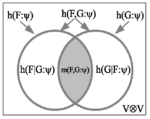For a century, quantum theorists have been reading the mathematical entrails of quantum mechanics (QM) to divine the nature of quantum reality. But to little avail. Let’s try a new approach.
Born Again! The Born Rule as a Feature of Superposition
Where does the Born Rule come from? We ask: “What is the simplest extension of probability theory where the Born rule appears”? This is answered by introducing “superposition events” in addition to the usual discrete events.
A new logical measure for quantum information
Logical entropy is compared and contrasted with the usual notion of Shannon entropy. Then a semi-algorithmic procedure (from the mathematical folklore) is used to translate the notion of logical entropy at the set level to the corresponding notion of quantum logical entropy at the (Hilbert) vector space level.
How to understand quantum mechanics
This paper tries to elucidate the paradoxical aspects of quantum mechanics (QM) by using a simplified pedagogical model of QM based on the support sets of the state vectors, by assuming an ontology of superposition-as-objective indefiniteness, and by not giving any ontological interpretation to the computational device of the wave function.
A Basic Duality in the Exact Sciences: Application to QM
This approach to interpreting quantum mechanics is not another jury-rigged or ad-hoc attempt at the interpretation of quantum mechanics but is a natural application of the fundamental duality running throughout the exact sciences.
A Pedagogical Model of Quantum Mechanics Over Sets
The new approach to quantum mechanics (QM) is that the mathematics of QM is the linearization of the mathematics of partitions (or equivalence relations) on a set. This paper develops those ideas using vector spaces over the field Z2 = {0.1} as a pedagogical or toy model of (finite-dimensional, non-relativistic) QM.
New Logic & New Approach to QM
The new logic of partitions is dual to the usual Boolean logic of subsets (usually presented only in the special case of the logic of propositions) in the sense that partitions and subsets are category-theoretic duals. The new information measure of logical entropy is the normalized quantitative version of partitions. The new approach to interpreting quantum mechanics (QM) is showing that the mathematics (not the physics) of QM is the linearized Hilbert space version of the mathematics of partitions. Or, putting it the other way around, the math of partitions is a skeletal version of the math of QM.
The Born Rule is a feature of Superposition
The Born Rule arises naturally out of the mathematics of probability theory enriched by superposition events. It does not need any more-exotic or physics-based explanation. No physics was used in the making of this paper. The Born Rule is just a feature of the mathematics of superposition.
The new partitional approach to (literally) interpreting quantum mechanics
This paper presents a new `partitional’ approach to understanding or interpreting standard quantum mechanics (QM). The thesis is that the mathematics (not the physics) of QM is the Hilbert space version of the math of partitions on a set and, conversely, the math of partitions is a skeletonized set level version of the math of QM.
Partitions, Objective Indefiniteness, and Quantum Reality
This paper, published in the International Journal for Quantum Foundations, is a shorter introductory paper following up on my recent “Follow the Math!” paper in the Foundations of Physics. The point is to show that the mathematics of QM is the vector (Hilbert) space version of the mathematics of partitions at the set level. […]






